Oosterkerk (Hoorn)
1519 establishments in Europe1616 establishments in the Dutch RepublicDutch Reformed Church buildingsDutch building and structure stubsGothic architecture in the Netherlands ... and 4 more
HoornInfobox religious building with unknown affiliationReligious buildings and structures completed in 1616Rijksmonuments in North Holland

Oosterkerk or St. Anthony Church is a former Dutch Reformed Church in Hoorn, North Holland in the Netherlands. The church is a Rijksmonument and was designed in the Gothic style. The church's origins date back to 1450. The building that exists today was complete in 1616. Today, the church is a cultural center.
Excerpt from the Wikipedia article Oosterkerk (Hoorn) (License: CC BY-SA 3.0, Authors, Images).Oosterkerk (Hoorn)
Grote Oost,
Geographical coordinates (GPS) Address Nearby Places Show on map
Geographical coordinates (GPS)
| Latitude | Longitude |
|---|---|
| N 52.639579 ° | E 5.063345 ° |
Address
Oosterkerk (Sint-Antoniuskerk)
Grote Oost 58
1621 BX (Hoorn)
North Holland, Netherlands
Open on Google Maps









